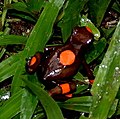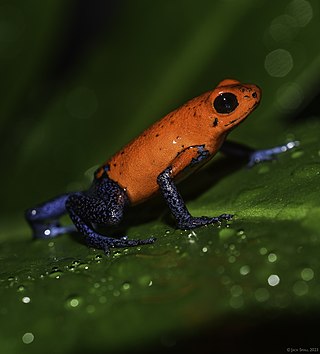Oophaga
Genus of amphibians From Wikipedia, the free encyclopedia
Oophaga is a genus of poison-dart frogs containing twelve species, many of which were formerly placed in the genus Dendrobates.[1] The frogs are distributed in Central and South America, from Nicaragua south through the El Chocó to northern Ecuador (at elevations below 1,200 m (3,900 ft)).[1][2] Their habitats vary with some species being arboreal while other being terrestrial,[3] but the common feature is that their tadpoles are obligate egg feeders.[3][1][4][5] Most species in this genus are seriously threatened and O. speciosa is already extinct.[6]
| Oophaga | |
|---|---|
 | |
| Oophaga pumilio | |
| Scientific classification | |
| Domain: | Eukaryota |
| Kingdom: | Animalia |
| Phylum: | Chordata |
| Class: | Amphibia |
| Order: | Anura |
| Family: | Dendrobatidae |
| Subfamily: | Dendrobatinae |
| Genus: | Oophaga Bauer, 1994 |
| Type species | |
| Dendrobates pumilio Schmidt, 1857 | |
| Diversity | |
| 12 species (see text) | |
Etymology
Oophaga, Greek for "egg eater" (oon, phagos),[7][8] is descriptive of the tadpoles' diet.[9][10]
Reproduction
While presumably all dendrobatids show parental care, this is unusually advanced in Oophaga: the tadpoles feed exclusively on trophic (unfertilized) eggs supplied as food by the mother; the father is not involved.[1][4] Through the eggs, the mother also passes defensive toxins to the tadpoles: Oophaga pumilio tadpoles experimentally fed with eggs from alkaloid-free frogs did not contain alkaloids.[11]
Species
Summarize
Perspective
There are twelve species in this genus:[2]
| Image | Scientific name | Common name | Distribution |
|---|---|---|---|
 |
Oophaga anchicayensis (Posso-Terranova and Andrés, 2018) | Chocó region of northwestern Colombia | |
| Oophaga andresi (Posso-Terranova and Andrés, 2018) | Cocorro | Columbia | |
| Oophaga arborea (Myers, Daly, and Martínez, 1984) | Polkadot poison frog | Panama | |
 | Oophaga granulifera (Taylor, 1958) | Granular poison frog | Costa Rica and Panama |
 | Oophaga histrionica (Berthold, 1845) | Harlequin poison frog | El Chocó region of western Colombia |
 | Oophaga lehmanni (Myers and Daly, 1976) | Lehmann's poison frog | western Colombia |
| Oophaga occultator (Myers and Daly, 1976) | La Brea poison frog | Cordillera Occidental in the Cauca Department of Colombia | |
 | Oophaga pumilio (Schmidt, 1857) | Strawberry poison-dart frog | eastern central Nicaragua through Costa Rica and northwestern Panama |
 |
Oophaga solanensis (Posso-Terranova and Andrés, 2018) | Koe-koe | Northwestern region of Colombia, on the western banks of the Atrato and san Juan rivers |
 | Oophaga speciosa (Schmidt, 1857) | Splendid poison frog | Cordillera de Talamanca, western Panama (extinct) |
 | Oophaga sylvatica (Funkhouser, 1956) | Diablito poison frog | southwestern Colombia and northwestern Ecuador. |
 | Oophaga vicentei (Jungfer, Weygoldt, and Juraske, 1996) | Vicente's poison frog | Veraguas, Bocas del Toro, Colón and Coclé Provinces of central Panama |
Captivity
Oophaga may be kept as pets by experienced amphibian keepers, but they are challenging to breed in captivity as only parents can feed and care for tadpoles.[3]
References
Wikiwand - on
Seamless Wikipedia browsing. On steroids.
